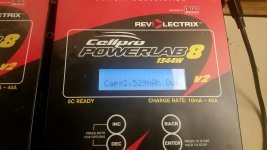Not at all.RickM39 said:Other than Luna only two (em3ev and lectric cycle) provided information on what type of cells were used and only em3ev specified configuration, all the others just stated the voltage and AH's.
Both also rated the packs according to the cell rating just like Luna.
EM3EV (a battery manufacturer) has banks of in-house cell testing rigs (I've seen their cell test, CNC, and die stamping equipment on a live video tour with Paul and Justin). For many years they have based their advertised battery capacity not on published manufacturer cell capacity, but rather on de-rated cell capacity from in-house tests - see below.
EM3EV Battery Spec from web site said:Typical Battery Specification:
- We use 14S (50.4V, based on 14*3.6V), not 13S (46.8V nominal, based on 13* 3.6V) like everybody else, so that means a working voltage of over 48V most of the time and it also means that you're getting that much more capacity than you would have had with an equivalent 13S Pack from somewhere else (7.7% extra versus a 13S equivalent). Our 14S NCM packs have very similar charge and discharge voltages to our 16S A123 packs.
- We conservatively rate the cells as 2.45Ah (25R), 2.10Ah (22P), 2.85Ah (29E) and 2.95Ah (30Q) and 3.15Ah (32E). Although the manufacturer classes them a little higher than this. Like with any Li Ion type battery, best long term performance is obtained by not using all of the available capacity all of the time.
- Energy Density of 150Whrs plus for finished pack.
- Cycle Life estimated at 500 cycles plus. Cycle life is extended by charging to 90% and limiting discharge to 90%. We make it easy to control the Charge voltage with our switching charger. To accurately limit discharge the Cycle Analyst is a great tool.
- PPTC thermal fuses used on all signal wires. If a fault were to ever occur on any of the small balance wires which run around the battery pack, the fuse simply shuts down the connection and keeps everything safe. Once the fault condition is removed, function returns to normal.
- Charge Voltage of 58.8V for 100% Charge, 57.4V for 90% Charge (our NCM chargers include a switch to charge to 100%, 90% and 50%).
- Maximum Charge Current 12A max (BMS limited).
- Whilst the 22P cell is 3C rated and can deliver 2C or more continuously, it is recommended not to run them at these levels on a routine basis. The 29E and 32E cells are 2C rated and we recommend a Max of closer to 1.5C. If your setup and usage means that the pack will be operated at high continous Current levels, consider the 25R or 30Q Packs which can deliver very high current levels without strain. Recommended Max Discharge Current: 22P pack - 30A, 29E Pack - 30A, 32E Pack - 35A, 25R Pack - 40A+, 30Q - 40A+. The 25R and 30Q Packs can easily delivery 40A continuous or more, but the packs are limited to 40A Continuous by the BMS, although the BMS can easily deliver much more for extended bursts.
- Dimensions: 75mm thick. 250mm long, 150mm wide.
- Weight: 4.9kg (22P and 25R), 5.2kg (29E, 32E and 30Q), not including charger or packaging.
Of course, EM3EV uses only authentic cells - no cheap knock-offs. This is a firm that has been innovating for us for many years and posting detailed specs with realistic ratings.
And, yes - I buy my batteries from EM3EV - I believe in patronage for companies that have a track record of developing and bringing new top-quality products to market - not just copying someone else's development efforts (e.g. triangle pack, 3-voltage charger)...



